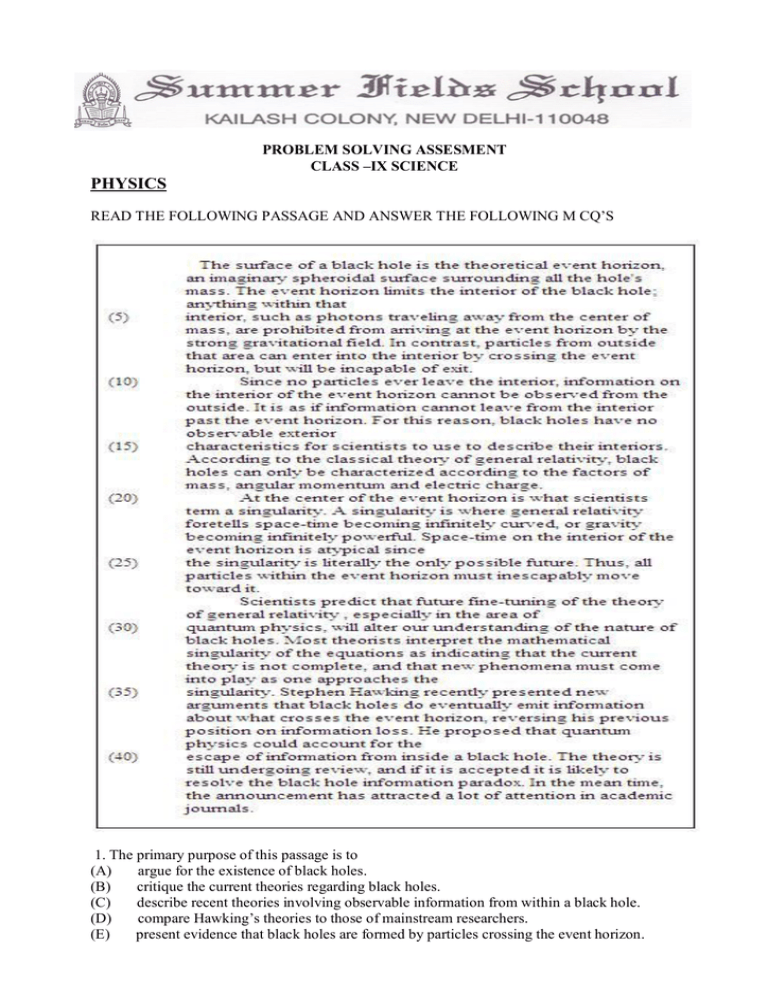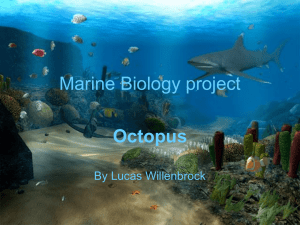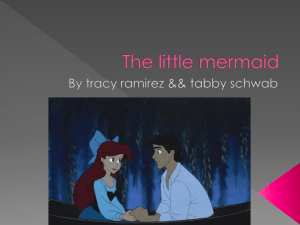PHYSICS
advertisement

PROBLEM SOLVING ASSESMENT CLASS –IX SCIENCE PHYSICS READ THE FOLLOWING PASSAGE AND ANSWER THE FOLLOWING M CQ’S 1. The primary purpose of this passage is to (A) argue for the existence of black holes. (B) critique the current theories regarding black holes. (C) describe recent theories involving observable information from within a black hole. (D) compare Hawking’s theories to those of mainstream researchers. (E) present evidence that black holes are formed by particles crossing the event horizon. 2. The passage implies which of the following about black holes? (A) Particles from the interior of a black hole are so transformed when they cross back through the event horizon that they are atypical and cannot be used to characterize the black hole. (B) The classical theory of general relativity states that black holes cannot be characterized by contents within the interior of the event horizon. (C) Black holes cannot be characterized by angular momentum. (D) Electric charge cannot be measured from within a black hole. (E) We can only make guesses as to the specific mass of a black hole. 3. According to the passage, which one of the following is true regarding singularities. (A) The singularity is the theoretical spheroidal surface surrounding the mass of a black hole. (B) The singularity is composed of particles traveling away from the center of mass. (C) All particles in the interior of the event horizon must move toward the singularity. (D) Particles move away from the singularity but are bound by the event horizon. (E) The singularity can account for the escape of information from inside a black hole. 4. The author implies which of the following? (A) Quantum physics cannot account for the escape of information from inside a black hole. (B) Certain events have not yet been accounted for in theories regarding the singularity. (C) Stephen Hawking’s recently presented arguments about information emitted from black holes challenges the accepted views of quantum physics. (D) Academic journals are only interested in theories from leading physicists. (E) Mathematical equations indicate that the singularity does not actually exist. 5. The author refers to Stephen Hawking in the fourth paragraph primarily to (A) illustrate some common misconceptions about black holes. (B) demonstrate that we are still refining our understanding of black holes. (C) describe recent theories of quantum physics. (D) show the differences between quantum physics and theories of general relativity. (E) reinforce similarities between two theories about the event horizon. MCQ’S Q1.I take a walk and am climbing a steep hill with a sandy surface .Choose the correct option related to above situation : (a) I climb on my toes. (b) I’ll use the full surface of my shoes (c) I’ll walk on my heels. (d) None of the above 2. A particle experiences constant acceleration for 20 seconds after starting from rest. If it travels a distance s1 in the first 10 seconds and distance s2 in the next 10 seconds then, (a) s2 = s1 (b) s2 = 2s1 (c) s2 = 3s1 (d) s2 = 4s1 3. An iron sphere of mass 10 kg has the same diameter as an aluminium sphere of mass is 3.5 kg. Both spheres are dropped simultaneously from a tower. When they are 10 m above the ground, they have the same (a) acceleration (b) momenta (c) potential energy (d) kinetic energy 4.Observe the following table, related to an object dropped from a height: Floor 8 16 24 32 40 Distance from Ground (in ft.)(d) 96 192 288 384 480 Drop time (sec.)(t) 2.45 3.46 4.24 4.90 5.48 A good model for the relationship between dropping time t and the distance d is the mathematical function: (a) t=4x d2 (b) d = 16t2 (c) d = 8 t2 (d) none of the above BIOLOGY Some people say that the best defense is a good offense; an octopus, however, would disagree. In addition to being one of the strangest and most beautiful creatures in nature, the octopus has some of the most inventive and effective defense mechanisms imaginable. While other animals have teeth, horns, or claws to help defend them from predators, the octopus concentrates its energy on hiding from and confusing its attackers. When it wants to get away, the octopus has an impressive arsenal of tricks at its disposal. The most well-known of the octopus’s defense mechanisms is its ability to squirt clouds of ink into the water. Some octopi use this cloud of ink as camouflage; after squirting the ink, the octopus retreats into the ink cloud where the predator cannot see it. Other octopi use the ink cloud as a decoy. If a large, intelligent predator such as a shark knows that octopi use ink clouds for camouflage, it might simply attack the ink cloud blindly, hoping to make contact with the octopus inside. However, some sneaky octopi will release the ink cloud in one direction and scurry away in another direction, leaving the predator with nothing but a mouthful of ink. In addition to confusing predators’ sense of sight, these ink clouds also confuse their sense of smell. The ink is composed primarily of melanin (the same chemical that gives human skin its color), which can shut down a predator’s sense of smell. If an octopus cannot be seen or smelled, it has a much higher chance of escaping an attack. Another defense mechanism possessed by many octopi is the ability to change color, much like a chameleon. Most animals get their skin color from chemicals in the skin called chromatophores (melanin is one of these chromatophores). Chromatophores might contain yellow, orange, red, brown, or black pigments, and the amount of each pigment present in the skin determines an animal’s color. While most animals are always the same color, some species of octopi can control the amount of each color pigment in their skin cells, allowing them to change color. Some poisonous octopi, when provoked, will change their skin to a bright, eye-catching color to warn predators that they are dangerous and ready to strike. Other octopi use this ability to change their skin to the color and texture of seaweed or coral, allowing them to blend in with their environment. Finally, some octopi—such as the mimic octopus—use this color-changing ability to masquerade as another type of animal. The body of an octopus is highly flexible, and some species can combine this flexibility with their color-changing skills to make themselves resemble more dangerous animals such as sea snakes or eels. Yet another defense mechanism possessed by some octopi is the ability to perform an autotomy, or self-amputation, of one of their limbs and regrow it later. Many species of skink and lizard also possess this ability, which allows them to shed their tails when caught by a predator and therefore get away. When a predator catches a tentacle the octopus can amputate this tentacle, thereby unfettering itself, and regrow the tentacle later. Some octopi, however, are even cleverer. When threatened by a predator, these octopi will shed a tentacle before being attacked in the hope that the predator will go after the detached tentacle rather than the octopus itself. While the octopus may not be the most vicious creature in the ocean, its numerous and clever defense mechanisms help it to survive in the dangerous undersea world. Questions: 1)Which of the following sentences from the passage best expresses the main idea? A. The most well-known of the octopus’s defense mechanisms is its ability to squirt clouds of ink into the water. B. Some people say that the best defense is a good offense; an octopus, however, would disagree. C. Another defense mechanism possessed by many octopi is the ability to change color, much like a chameleon. D. When it wants to get away, the octopus has an impressive arsenal of tricks at its disposal. 2) The author claims in paragraph 1 that an octopus would disagree with the statement “the best defense is a good offense” because A. octopi employ more defensive than offensive capabilities B. octopi possess good defensive and offensive capabilities C. octopi can protect themselves from teeth, horns, and claws D. not all octopi possess the same defense mechanisms 3) Which of the following statements best describes the organizational structure of paragraphs 24? A. The author lays out several reasons to support the argument that the octopus has the best defense mechanisms of any sea creature. B. The author devotes one paragraph each to explaining three different defense mechanisms possessed by the octopus. C. The author devotes one paragraph each to highlighting three potential threats to the octopus and how the octopus deals with each one differently. D. The author compares and contrasts three different defense mechanisms employed by the octopus. 4) According to the passage, which of the following statements about the chemical melanin are true? I. An octopus’s ink is composed primarily of melanin. II. Melanin is a chromatophore. III. Like the octopus, chameleons use melanin to change color. A. I only B. I and II only C. II and III only D. I, II, and III 5) As used in paragraph 4, which of the following is the best synonym for unfettering? A. freeing B. regrowing C. amputating D. sacrificing 6) The final paragraph can best be described as a A. prediction conclusion, in which the author looks toward the future B. full circle conclusion, in which the author incorporates and builds on a word or theme from the introduction C. solution conclusion, in which the author proposes a solution to a problem posed earlier in the passage D. summary conclusion, in which the author restates the passage’s main idea . CHEMISTRY II. When hydrated copper sulphate is heated to obtain anhydrous copper sulphate, the no. of water molecules changed to vapour state are: a) 4 b) 5 c) 3 d) 2 III) The solvent of sulphur is: a) Water b) carbon sulphide c) ethyl alcohol d) calcium carbide IV) The reaction between Na2SO4 and BaCl2 (aq) is not called. a) Double displacement c) Double precipitation b) precipitation d)Precipitaion




![WIA poetry exercise[1]](http://s3.studylib.net/store/data/006641954_1-9e009b6b11d30a476e3c12c4ba5f8bb1-300x300.png)